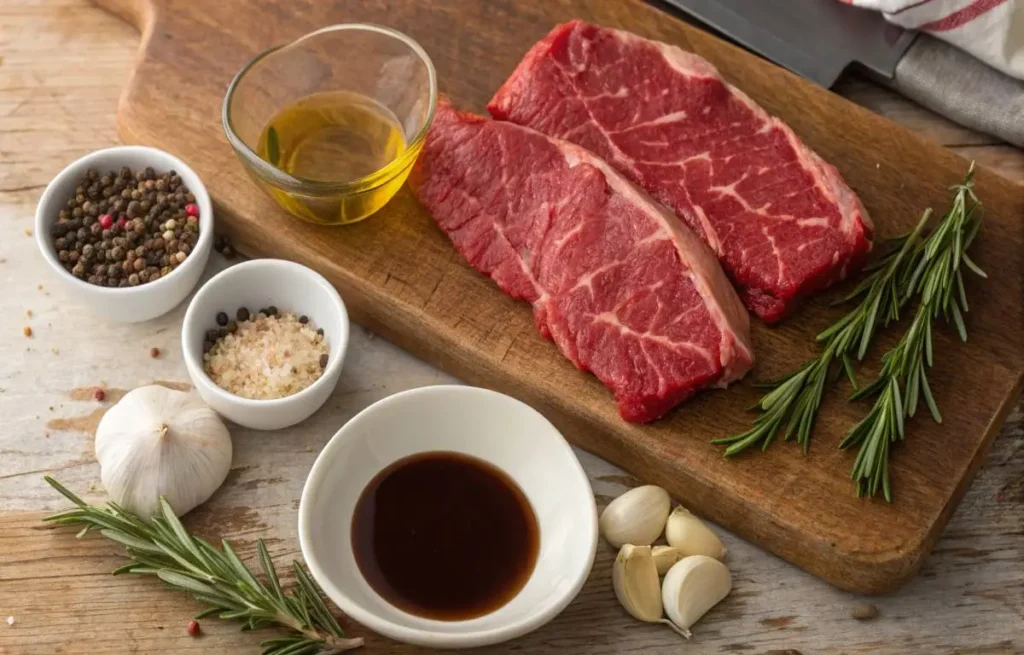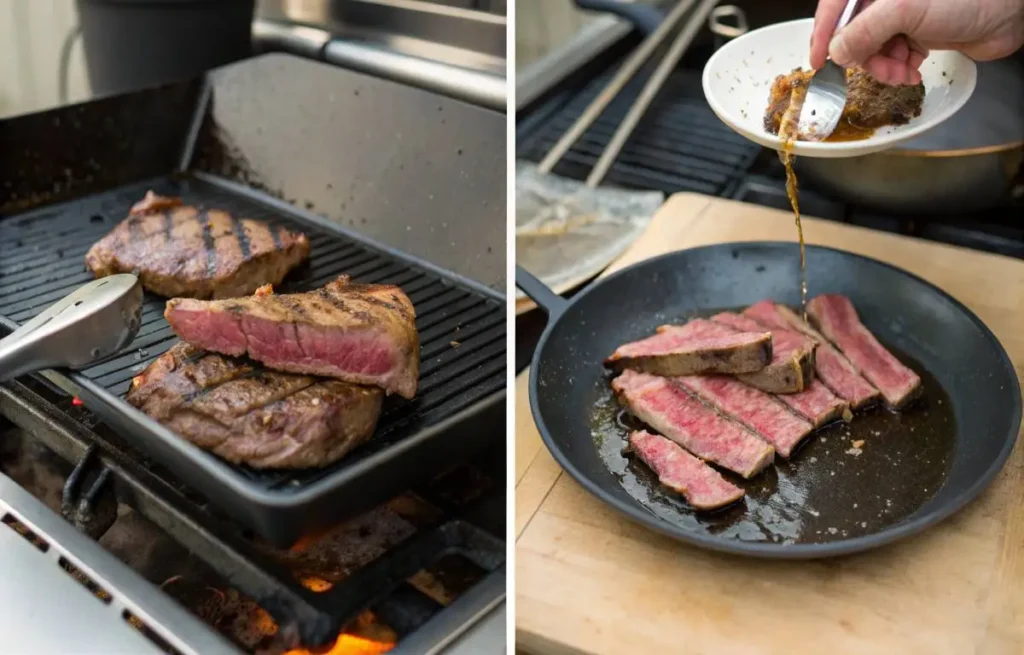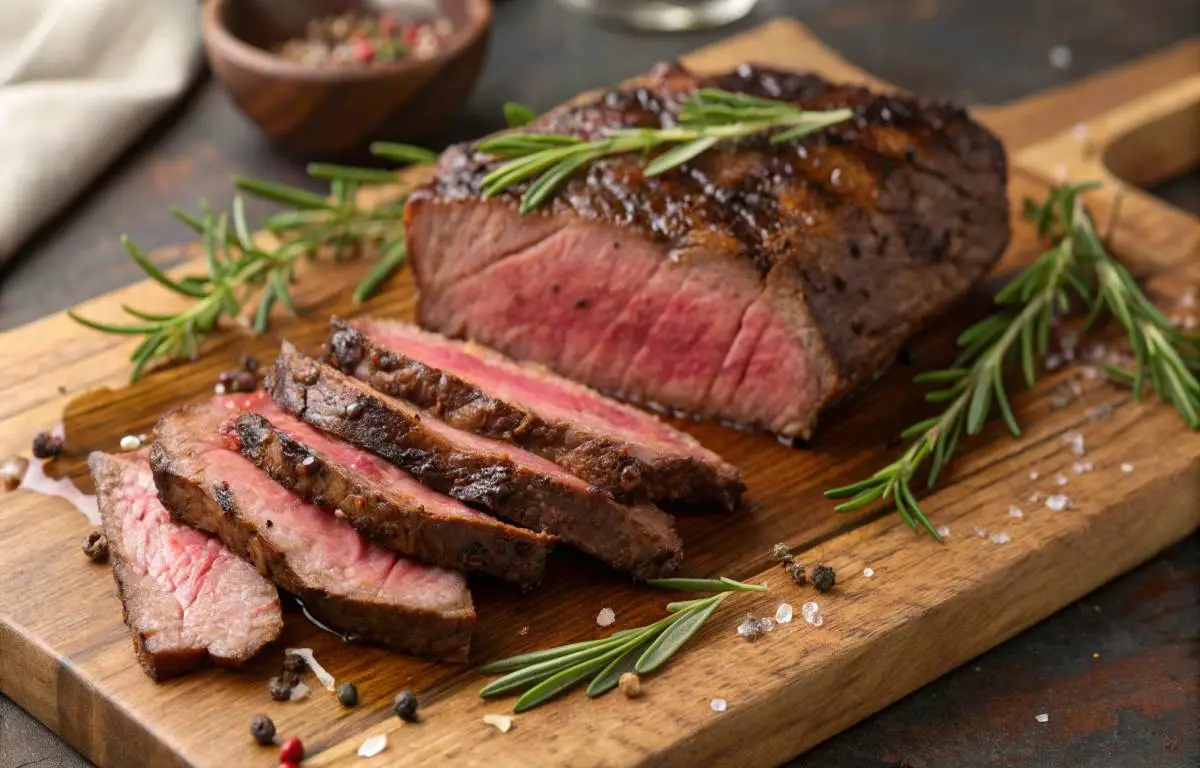The first time I came across beef flap meat steak, it wasn’t in some fancy restaurant or hyped-up food video. It was actually at the butcher’s counter, tucked behind the usual suspects—ribeye, sirloin, all the cuts people know by heart. The guy behind the counter looked at me, nodded, and said, “If you’re grilling tonight, try this instead.” He wrapped it up like he was handing me a secret. Honestly? He kinda was.
That night, I cooked it not expecting much… and ended up with one of the juiciest, most flavorful steaks I’d ever had. No exaggeration. Flap meat looks unassuming—kinda weird, even—but once it hits the heat, something magical happens. It’s rich, it’s deeply beefy, and when you slice it right, it practically melts in your mouth.
Since then, it’s been my go-to. Friday nights, birthdays, cookouts—you name it. And without fail, someone always takes a bite, looks up, and says, “Wait… what is this cut?” That’s when I grin and tell them, “Beef flap meat steak. And no, I’m not giving you the last piece.”
Ingredients

What You’ll Need for the Steak
- 1.5 to 2 pounds of beef flap meat steak
(Can’t find flap? Ask for bavette or sirloin flap. Same vibe.) - 1 tablespoon kosher salt
- 1 teaspoon cracked black pepper
- 1 tablespoon olive oil
Optional But Totally Worth-It Marinade
- 3 tablespoons soy sauce
- 1 tablespoon Worcestershire sauce
- 2 tablespoons lime juice (lemon works too)
- 4 garlic cloves, minced
- 1 tablespoon brown sugar
- 1 teaspoon smoked paprika
- A pinch of chili flakes (if you like some heat)
Easy Swaps (in case your pantry’s looking empty)
- No flap meat? Try bavette steak or sirloin tip. They’re from the same part of the cow and cook up just as tender.
- Gluten-free? Tamari swaps right in for soy sauce.
- No lime? Use apple cider vinegar or even balsamic for a different twist.
- No brown sugar? Go with honey or maple syrup.
And hey, if you’re skipping the marinade, don’t worry. Just hit the steak with a bold rub: salt, pepper, garlic powder, and paprika. Simple, but super flavorful.
Timing Breakdown
- Prep time: ~10 minutes
- Marinate time: 1 to 8 hours (if you’ve got the time, let it soak)
- Cook time: 10–12 minutes
- Rest time: 5 minutes (don’t skip it—seriously)
- Total time: Around 25 minutes (plus marinade time if you go that route)
Step-by-Step Detailed Instructions

1. Trim the Meat (if needed)
If your steak has any silver skin or thick fat, grab a sharp knife and carefully trim it off. You’ll want to clearly see the grain — that’s the direction of the muscle fibers — because slicing against it later is key for tenderness.
2. Marinate (Optional, but Totally Worth It)
Mix up your marinade ingredients in a big zip-top bag or shallow dish. Toss in the steak, making sure it’s coated all over. Pop it in the fridge for at least an hour, or up to 8 hours if you’ve got the patience.
Quick tip: Don’t go past 12 hours—the acids in the marinade can start to mush up the meat.
3. Bring It to Room Temperature
About half an hour before you cook, take the steak out of the fridge. Pat it dry with some paper towels and brush on a little olive oil.
Why? Dry surface = better sear and more flavor.
4. Preheat Your Grill or Cast Iron Pan
Heat it up nice and hot. You want it sizzling when the steak hits the surface — that’s what locks in all those juicy flavors.
5. Season and Sear
Generously sprinkle kosher salt and cracked black pepper all over. Then, place your steak on the grill or pan. Let it sear for 4 to 6 minutes per side until a beautiful crust forms. Aim for an internal temp of about 130–135°F if you like it medium-rare.
Heads up: The USDA says 145°F for safety, but many chefs swear by 130°F for juicy, tender steak.
6. Let It Rest
Take your steak off the heat and let it chill on a cutting board, loosely covered with foil, for about 5 minutes. This lets the juices settle so every bite stays juicy.
7. Slice Against the Grain
Grab a sharp knife and slice thinly across the grain — not with it.
Pro tip: The grain often runs at a slight angle, so pay close attention. Slicing the wrong way can make the steak tough, and nobody wants that.
Nutritional Info with Explanations
Per 6 oz cooked serving (without marinade):
- Calories: ~340
- Protein: 32g
- Fat: 22g (10g saturated)
- Carbs: 0g
- Iron: ~20% DV
- Zinc: ~30% DV
Flap meat is a high-protein, iron-rich cut. It’s less fatty than ribeye but still juicy. According to the USDA FoodData Central, flap meat contains slightly more intramuscular fat than flank steak, making it both tender and flavorful.
Healthier Alternatives
If you’re trying to cut back on fat but still want to enjoy flap meat steak, there are a few simple things you can do. Start by trimming off any visible fat before cooking—it helps without making the steak dry. Skip the extra oil if you can, and cook it on a good nonstick pan or grill so it won’t stick and you won’t need added fat.
For the marinade, go heavy on citrus—like lime or lemon juice—and leave out any sugar or sweet stuff. The acid tenderizes the meat and adds fresh flavor without extra calories.
And when you’re plating up, try lighter sides—grilled zucchini, a fresh quinoa salad, or roasted veggies work really well. They add good nutrients and keep the meal feeling balanced.
A dietitian I follow, Kelly Jones, points out that lean cuts like flap meat are great for iron and zinc, which your body needs for energy and immune health. Plus, pairing the steak with vitamin C-rich foods—like a squeeze of lemon or some tomatoes—can help your body absorb that iron better. Small tip, big difference
Serving Suggestions
Honestly, beef flap meat steak is way more versatile than it looks. You can slice it thin for tacos with some creamy avocado and fresh salsa, or pile it over a simple salad dressed with chimichurri and roasted corn. If you’re in the mood for something classic, mashed potatoes and sautéed mushrooms make a cozy pairing.
For sandwiches, caramelized onions and a garlicky aioli take it up a notch. And depending on the season, switch up the sides — in summer, think grilled peaches and corn on the cob; in cooler months, roasted root veggies and a good red wine work wonders.
Common Mistakes to Avoid
A few things can mess up your steak if you’re not careful: don’t toss it on the grill cold—let it warm up to room temp first. And don’t marinate for too long; anything over 12 hours can make the texture weird. Also, drying the steak before cooking is a small step that really helps with getting a nice sear.
If you’re not sure about cooking times, a meat thermometer is your friend. And definitely slice across the grain—cutting with it just makes it tough.
Storing Tips
If you have leftovers (which might be unlikely!), keep them in an airtight container in the fridge for a couple of days. For longer storage, wrap it up tight and freeze it — just remember to slice before freezing if you want to use it later in salads or sandwiches.
When reheating, do it low and slow in a pan with a little broth or water to keep it from drying out.
Conclusion
Flap meat steak might not be as glamorous as ribeye or filet, but it’s got its own kind of magic. Tender, flavorful, and surprisingly affordable, it’s become one of my go-tos. There’s something kind of special about sharing a cut that surprises people.
If you haven’t given it a shot yet, seriously, try it. And if you have, I’d love to hear how you cooked it and what sides you paired it with. Drop a comment and let’s chat!
People Also Read
Chicken Crust Pizza Recipe They Beg Me to Make
Pasta Fresca Recipe Made for Date Nights
FAQs
What exactly is beef flap meat steak?
It’s a cut from the bottom sirloin, close to the flank area. In French cooking, it’s often called bavette steak. The cut is long, flat, and has a loose grain, which makes it packed with flavor and pretty easy to cook.
Is flap meat the same as flank or skirt steak?
Not quite. Flap meat usually has more marbling than flank steak and is thicker than skirt steak. While all three are great for grilling and slicing thin, flap meat tends to be juicier when cooked right.
Do I have to marinate flap meat before cooking?
You don’t have to. Just seasoning it simply with salt and pepper works fine. That said, marinating can really add an extra layer of flavor, especially if you’re grilling.
How can I tell which way the grain runs?
Check out the muscle fibers — they usually run diagonally across the steak. When slicing, always cut against the grain to keep the meat tender.
Why does my flap steak sometimes turn out chewy?
That usually happens if it’s overcooked or if you slice it the wrong way, along the grain. For the best tenderness, cook it to medium-rare or medium, let it rest a few minutes, then slice thinly across the grain.

